Apple E3091A Cellular Phone with Bluetooth and WLAN Radios User Manual AA15XX User Guide v1 0x
Apple Inc. Cellular Phone with Bluetooth and WLAN Radios AA15XX User Guide v1 0x
Apple >
Contents
- 1. RF exposure statements (FCC only)
- 2. User_Guide_v1.0_draft_Part1
- 3. User_Guide_v1.0_draft_Part2
- 4. User_Guide_v1.0_draft_Part3
- 5. User_Guide_v1.0_draft_Part4
- 6. User_Guide_v1.0_draft_Part5
- 7. User_Guide_v1.0_draft_Part6
- 8. User_Guide_v1.0_draft_Part7
- 9. User_Guide_v1.0_draft_Part8
- 10. Manual part1
- 11. Manual part2
User_Guide_v1.0_draft_Part4

46
!
APPLE CONFIDENTIAL
Open Control Center. Swipe up from the bottom edge of any screen (even the Lock
screen). If you’ve set up accessories in the Home app, you can also swipe Control
Center right to reach accessory controls.
3D Touch. Press the Flashlight, Timer, or Camera to view a list of quick actions. See
3D Touch.
Control audio. Swipe Control Center left to quickly reach audio controls. Tap the song
title to open the currently playing audio app.
If you set up your iPhone with speakers, headphones, Apple TV, or another audio
device, tap
to switch the audio output. For information about setting up iPhone with
audio devices using Bluetooth, see Bluetooth devices.
Open the currently playing audio app. Tap the song title.
DRAFT

47
!
APPLE CONFIDENTIAL
Control home accessories. Swipe Control Center right to reach accessory controls if
you’ve set up accessories in the Home app.
Close Control Center. Swipe down, tap the top of the screen, or press the Home button.
Turn off access to Control Center in apps or on the Lock screen. Go to Settings >
Control Center.
Search
You can search iPhone, the Internet, and apps for useful information including:
Sports scores and schedules
Weather forecasts
Stock prices
Quick conversions
Calculations
Places nearby
Media, including music, TV shows, movies, and web videos
Websites
Content in apps (for supporting apps)
Siri provides more information even before you start to type. Siri suggests:
Relevant people
Suggested apps
Places nearby
Items in the news
Search with iPhone. Swipe down from the middle of the Home screen to show Search.
Tap an item to get more information, or tap the search field. Results occur as you type;
to hide the keyboard and see more results on the screen, tap Search. Tap an item in the
list to open it.
COMMENT: FPO screenshot below
DRAFT
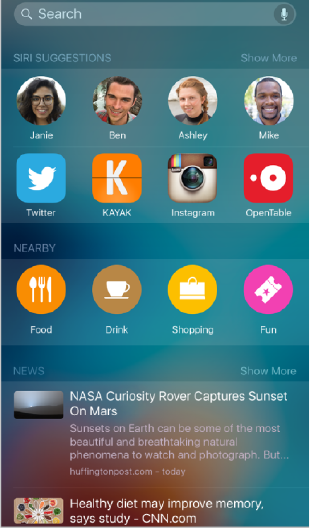
48
!
APPLE CONFIDENTIAL
Choose what to search. Go to Settings > General > Spotlight Search, then tap to
deselect apps or content.
Turn off Siri Suggestions and Suggestions in Search. Go to Settings > General >
Spotlight Search.
Turn off Location Services for Spotlight Suggestions. Go to Settings > Privacy >
Location Services. Tap System Services, then turn off Safari & Spotlight Suggestions.
Search in apps. Many apps include a search field where you can type to find something
within the app. For example, in the Maps app, you can search for a specific location.
DRAFT

49
!
APPLE CONFIDENTIAL
Siri
Make requests
Siri lets you speak to your iPhone to send messages, schedule meetings, place phone
calls, and much more. Siri understands natural speech, so you don’t have to learn special
commands or keywords. Ask Siri anything, from “set the timer for 3 minutes” to “what
movies are showing tonight?” Open apps, and turn features like Airplane Mode,
Bluetooth, Do Not Disturb, and VoiceOver on or off. Siri is great for keeping you updated
with the latest sports info, helping you decide on a restaurant, and searching the
iTunes Store or App Store.
Note: To use Siri, iPhone must be connected to the Internet. See Connect to the Internet.
Cellular charges may apply.
Summon Siri. Press and hold the Home button, release the button, then make your
request. Or, instead of waiting for Siri to notice that you’ve stopped talking, continue to
hold down the Home button while you speak, then release it when you finish.
If you’re using a headset, you can use the center or call button in place of the Home
button.
Hey Siri. You can use Siri without pressing the Home button. Just say “Hey Siri,” then
make your request. (For some models, Hey Siri is only recognized when iPhone is
connected to a power source.)
To turn Hey Siri on or off, and to identify if your device must be connected to a power
source to use it, go to Settings > Siri > Allow “Hey Siri”.
DRAFT
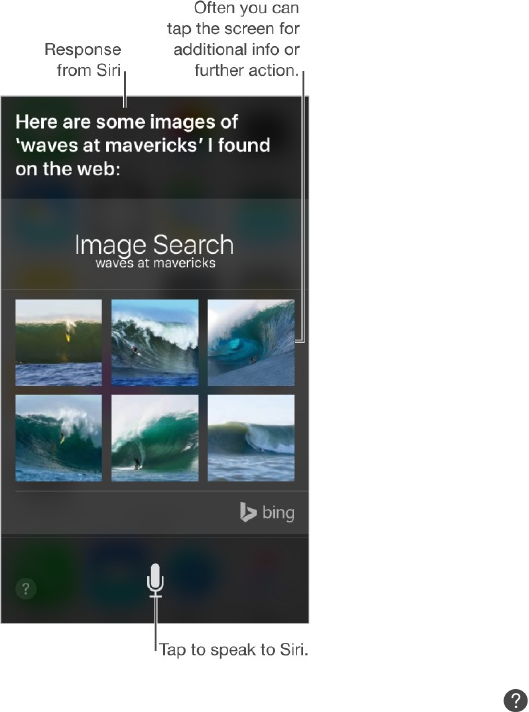
50
!
APPLE CONFIDENTIAL
Get Siri hints. Ask Siri “what can you do,” or tap .
The onscreen response from Siri often includes information or images that you can tap
for additional detail, or to perform some other action.
Change the voice gender for Siri. Go to Settings > Siri > Siri Voice (may not be available
in all areas).
Adjust the volume for Siri. Use the volume buttons while you’re interacting with Siri. For
voice feedback options, go to Settings > Siri > Voice Feedback.
Prevent access to Siri when iPhone is locked. Go to Settings > Touch ID & Passcode
(iPhone models with Touch ID) or Settings > Passcode (other models). You can also
disable Siri by turning on restrictions. See Set Restrictions.
Tell Siri about yourself
If you tell Siri about yourself—including things like your home and work addresses, and
your relationships—you can get personalized service like, “send a message to my wife.”
Tell Siri who you are. Fill out your info card in Contacts, then go to Settings > Siri > My
Info and tap your name.
To let Siri know about a relationship, say something like “Emily Parker is my wife” or
“Ailish Kimber is my mom.”
DRAFT

51
!
APPLE CONFIDENTIAL
Note: Siri uses Location Services when your requests require knowing your location. See
Privacy.
Siri and apps
Siri works with many of the apps on iPhone, including Phone, Messages, Maps, Clock,
Calendar, and more. For example, you can say things like:
“Call Mom at home”
“Do
I
have any new texts from Rick?”
“I’m running low on gas”
“Set an alarm for 8 a.m.”
To get personalized service for requests like “FaceTime Mom,” tell Siri about yourself and
your relationships. See Tell Siri about yourself.
More examples of how you can use Siri with apps appear throughout this guide.
Using Siri with third-party apps. Some apps from the App Store also support Siri.
These include apps that let you book a ride, send a message, search photos, send
payments, place calls, and track your workouts. Look for apps that work with Siri in the
App Store.
Make corrections
If Siri doesn’t get something right, you can tap to edit your request.
Or tap
again, then clarify your request verbally.
Want to cancel that last command? Say “cancel,” tap the Siri icon, or press the Home
button.
Want to change a message before sending it? Say “Change it.”
DRAFT
52
!
APPLE CONFIDENTIAL
Siri Eyes Free
With Siri Eyes Free, you can use iPhone features in your car without looking at or
touching iPhone—you can control it completely by speaking. To talk with Siri, press and
hold the voice command button on your steering wheel until you hear the Siri tone. You
can ask Siri to call people, select and play music, hear and compose text messages, get
directions, read your notifications, find calendar information, add reminders, and more.
Siri Eyes Free is available on select automobiles.
WARNING: For important information about avoiding distractions that could lead to
dangerous situations, see Important safety information.
Use Siri Eyes Free. Connect iPhone to your car using Bluetooth. Refer to the user guide
that came with your car.
For more information about using Siri in your car, see About CarPlay.
DRAFT
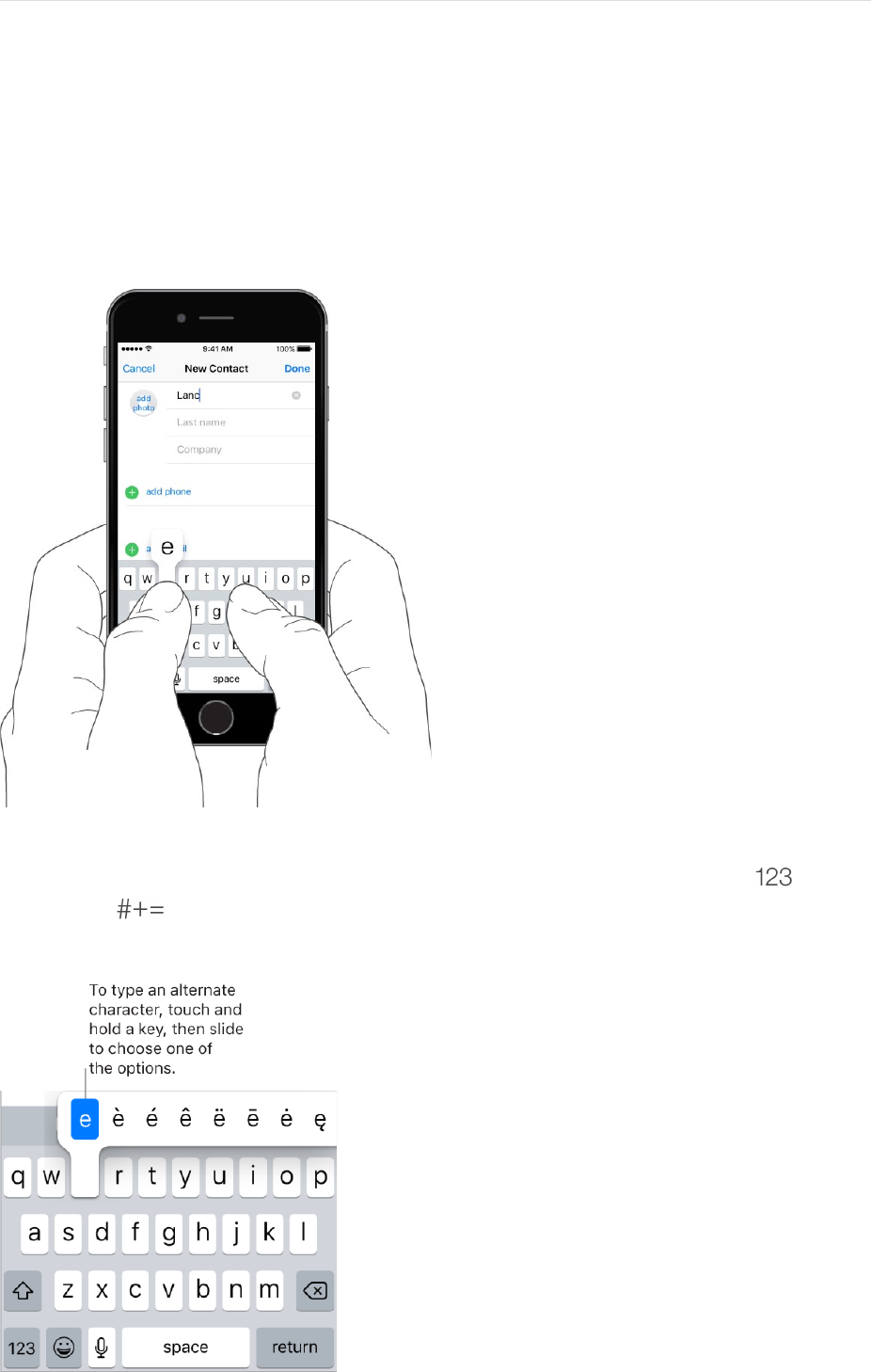
53
!
APPLE CONFIDENTIAL
Enter text
Type text
Tap a text field to see the onscreen keyboard, then tap letters to type. If you touch the
wrong key, you can slide your finger to the correct key. The letter isn’t entered until you
release your finger from the key.
Tap Shift to type uppercase, or touch the Shift key and slide to a letter. Double-tap Shift
for caps lock. To enter numbers, punctuation, or symbols, tap the Number key
or the
Symbol key
. To quickly end a sentence with a period and a space, just double-tap
the space bar.
DRAFT
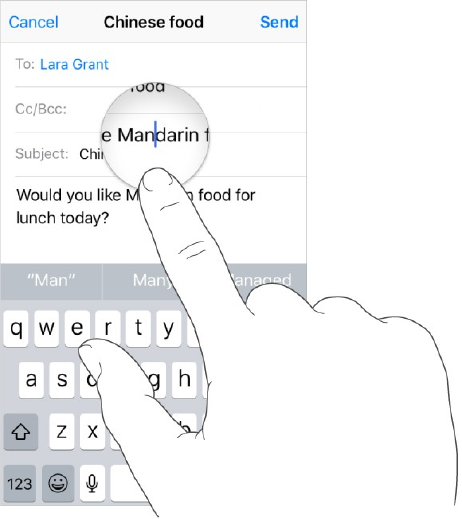
54
!
APPLE CONFIDENTIAL
If you see a word underlined in red, tap it to see suggested corrections. If the word you
want doesn’t appear, type the correction.
Set options for typing or add keyboards. Go to Settings > General > Keyboard.
The onscreen keyboard for iPhone 6, iPhone 6 Plus, iPhone 6s, and iPhone 6s Plus
includes additional keys you may find useful. You can see these keys when you hold
iPhone in landscape orientation.
You can also use an Apple Wireless Keyboard to enter text. See Use an Apple Wireless
Keyboard. To dictate instead of typing, see Dictate.
Edit text
Revise text. Touch and hold the text to show the magnifying glass, then drag to position
the insertion point.
Select text. Tap the insertion point to display the selection options. Or double-tap a
word to select it. Drag the grab points to select more or less text. In read-only
documents, such as webpages, touch and hold to select a word.
DRAFT
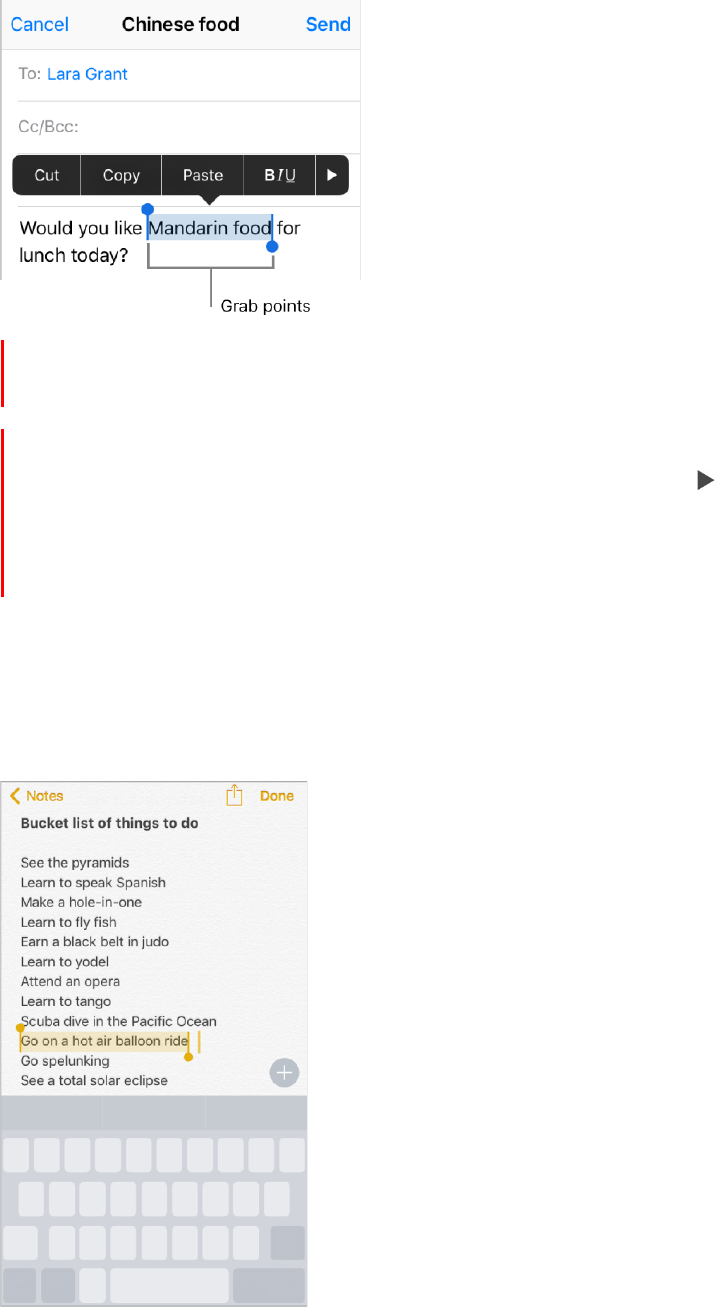
55
!
APPLE CONFIDENTIAL
You can cut, copy, or paste over selected text. With Universal Clipboard you can also
cut or copy something on one Apple device, and paste it on another.
With some apps, you can also get bold, italic, or underlined text (tap B/I/U); see
suggestions in Look Up; or have iPhone suggest an alternative. Tap
to see all the
options. If you choose Look Up, you see suggested information from the web and
different apps. To turn off Suggestions in Look Up, go to Settings > General > Spotlight
Search.
3D Touch. To turn your keyboard into a trackpad, press the keyboard until it turns
light gray. Move the cursor by dragging around the keyboard. Without lifting your finger,
press a little deeper to select a word. Press twice to select a sentence. Press three times
to select a paragraph. After pressing, you can drag to select more text. See 3D Touch.
Undo the last edit. Shake iPhone, then tap Undo.
DRAFT

56
!
APPLE CONFIDENTIAL
Predictive text
As you write, the keyboard predicts your next word, suggests emoji that could take the
place of your word, and makes suggestions based on your recent activity and information
from your apps (not available in all languages). For example, when you type something
like:
“I’m available at,” the free time in your calendar pops up as an option.
“My number is,” your phone number appears as an option.
Tap a word to choose it, or accept a highlighted prediction by entering a space or
punctuation. When you tap a suggested word, a space appears after the word. If you
enter a comma, period, or other punctuation, the space is deleted. Reject a suggestion
by tapping your original word (shown as the predictive text option with quotation marks).
Turn off predictive text. Touch and hold
or
, then slide to Predictive.
If you turn off predictive text, iPhone may still try to suggest corrections for misspelled
words. Accept a correction by entering a space or punctuation, or by tapping return. To
reject a correction, tap the “x.” If you reject the same suggestion a few times, iPhone
stops suggesting it.
Dictate
You can dictate instead of typing. Make sure Enable Dictation is turned on (in Settings >
General > Keyboard) and iPhone is connected to the Internet.
Note: Dictation may not be available in all languages or in all areas, and features may
vary. Cellular data charges may apply. See Cellular data settings.
Dictate text. Tap
on the onscreen keyboard or Search field, then speak. Tap Done
when you finish.
DRAFT

57
!
APPLE CONFIDENTIAL
Add text. Tap
again and continue dictating. To insert text, tap to place the insertion
point first. You can also replace selected text by dictating.
Add punctuation or format text. Say the punctuation or format. For example, “Dear
Mary comma the check is in the mail exclamation mark” becomes “Dear Mary, the check
is in the mail!” Punctuation and formatting commands include:
quote
…
end quote
new paragraph
new line
cap—to capitalize the next word
caps on
…
caps off—to capitalize the first character of each word
all caps—to make the next word all uppercase
all caps on
…
all caps off—to make the enclosed words all uppercase
no caps on
…
no caps off—to make the enclosed words all lowercase
no space on
…
no space off—to run a series of words together
smiley—to insert :-)
frowny—to insert :-(
winky—to insert ;-)
DRAFT
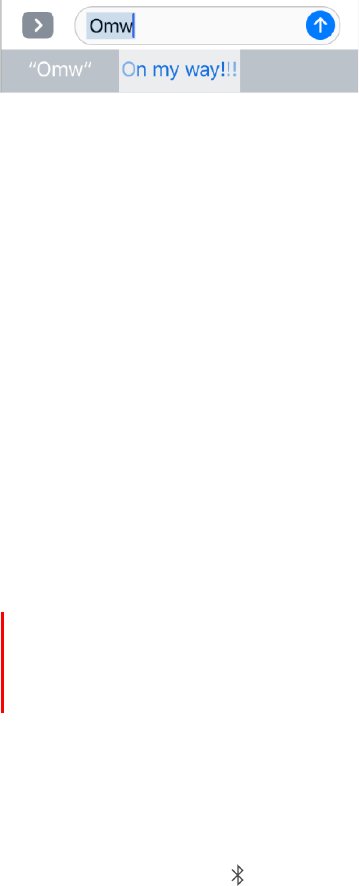
Keyboards > Add New Keyboard.
58
!
APPLE CONFIDENTIAL
Save keystrokes
A shortcut lets you enter a word or phrase by typing just a few characters. For example,
type “omw” to enter “On my way!” That one’s already set up for you, but you can also
add your own.
Create a shortcut. Go to Settings > General > Keyboard, then tap Text Replacement.
Have a word or phrase you use and don’t want it corrected? Create a shortcut, but
leave the Shortcut field blank.
Use iCloud to keep your personal dictionary up to date on your other devices. Go to
Settings > iCloud, then turn on iCloud Drive.
Use an Apple Wireless Keyboard
You can use an Apple Wireless Keyboard (available separately) to enter text on iPhone.
The keyboard connects via Bluetooth, so you must first pair it with iPhone.
Note: The Apple Wireless Keyboard may not support keyboard features that are on your
device. For example, you can’t enable dictation with Apple Wireless Keyboard.
Pair Apple Wireless Keyboard with iPhone. Turn the keyboard on. On iPhone, go to
Settings > Bluetooth and turn on Bluetooth, then tap the keyboard when it appears in
the Devices list.
Once it’s paired, the keyboard reconnects to iPhone whenever it’s in range—up to about
33 feet (10 meters). When it’s connected, the onscreen keyboard doesn’t appear.
Save your batteries. Turn off Bluetooth and the wireless keyboard when not in use. You
can turn off Bluetooth
in Control Center. To turn off the keyboard, hold down the On/off
switch until the green light goes off.
Add or change keyboards
You can turn typing features, such as spell checking, on or off; add keyboards for writing
in different languages; and change the layout of your onscreen keyboard or Apple
Wireless Keyboard.
Set typing features. Go to Settings > General > Keyboard.
Add a keyboard for another language. Go to Settings > General > Keyboard >
DRAFT

59
!
APPLE CONFIDENTIAL
If you’ve added keyboards in other languages, you can type in two languages at the
same time without having to switch between keyboards.
Switch keyboards. Touch and hold , then slide your finger to the name of the
keyboard.
You can also tap
to switch from one keyboard to the other. Continue tapping to
access other enabled keyboards.
For information about international keyboards, see Use international keyboards.
Change the keyboard layout. Go to Settings > General > Keyboard > Keyboards, select
a keyboard, then choose a layout.
Sounds and silence
You can change or turn off the sounds iPhone plays when you get a call, text, voicemail,
email, tweet, Facebook post, reminder, or other event.
Set sound options. Go to Settings > Sounds & Haptics (called Sounds on devices
without 3D Touch) for options such as ringtones and alert tones, vibration settings and
patterns, and ringer and alert volumes.
Set vibration patterns. Go to Settings > Sounds & Haptics (called Sounds on devices
without 3D Touch), then choose an item from the Sounds and Vibration Patterns list.
Tap Vibration to select a pattern or create your own.
If you want to temporarily silence incoming calls, alerts, and sound effects, see Do Not
Disturb.
Do Not Disturb
Do Not Disturb is an easy way to silence iPhone, whether you’re going to dinner or to
sleep. It keeps calls and alerts from making any sounds or lighting up the screen.
Turn on Do Not Disturb. Swipe up from the bottom edge of the screen to open Control
Center, then tap . When Do Not Disturb is on,
appears in the status bar.
Note: Even if Do Not Disturb is on, calls and messages from your emergency contacts
in Medical ID still come through as usual, and Alarms still sound.
Configure Do Not Disturb. Go to Settings > Do Not Disturb.
Tip: You can schedule quiet hours, allow calls from your Favorites, and allow repeated
calls to ring through for those emergency situations. You can also set whether Do Not
Disturb silences iPhone only when it’s locked, or even when it’s unlocked.
DRAFT
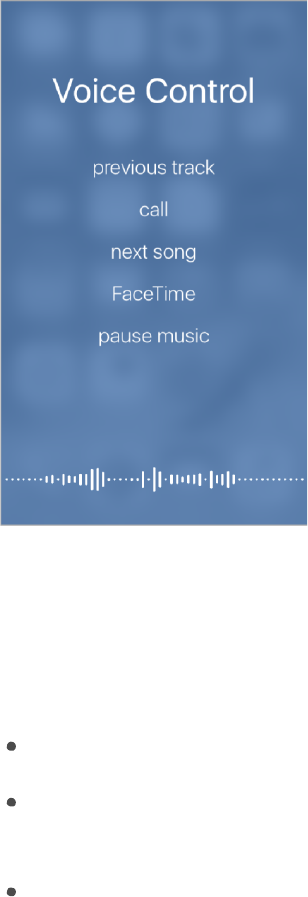
69
!
APPLE CONFIDENTIAL
Voice Control
Voice Control lets you make phone calls and FaceTime calls, and control music playback,
if you have Siri turned off. You may want to use Voice Control if you can’t use Siri
because
you’re not connected to the Internet. (For information about using Siri to control
iPhone
by voice, see Make requests.)
Note: Voice Control and Voice Control settings aren’t available when Siri is turned on.
Use Voice Control. Turn Siri off in Settings > General > Siri, then press and hold the
Home button until the Voice Control screen appears and you hear a beep, or press and
hold the center button on your headset. See Use your Apple headset.
For best results:
Speak clearly and naturally.
Say only Voice Control commands, names, and numbers. Pause slightly between
commands.
Use full names.
Change the language for Voice Control. By default, Voice Control expects you to speak
voice commands in the language that’s set for iPhone (in Settings > General > Language
& Region). To use Voice Control in another language or dialect, go to Settings >
General > International > Voice Control.
DRAFT
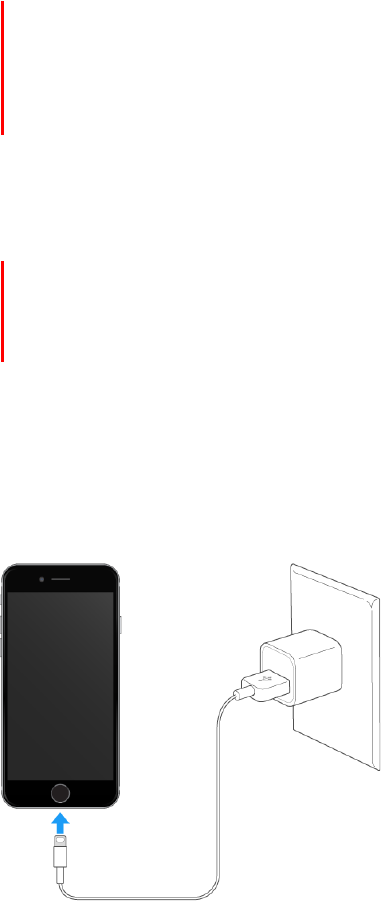
61
!
APPLE CONFIDENTIAL
Voice Control for the Music app is always on, but you can keep Voice Control from dialing
when iPhone is locked. Go to Settings > Touch ID & Passcode (iPhone 5s and later) or
Settings > Passcode (other models), then turn off Voice Dial.
For specific commands, see Make a call and Siri and Voice Control. For more about
using Voice Control, including information about using Voice Control in different
languages, go to the Apple support website Tips for using Voice Control with iPhone
and iPod touch.
Charge and monitor the battery
iPhone has an internal, lithium-ion rechargeable battery. For more information about the
battery—including tips for maximizing battery life—go to the Apple Lithium-ion
Batteries website .
WARNING: For important safety information about the battery and charging iPhone, see
Important safety information.
Charge the battery. Connect iPhone to a power outlet using the included cable and USB
power adapter.
Note: Connecting iPhone to a power outlet can start an iCloud backup or wireless iTunes
syncing. See Back up iPhone with iTunes and Sync with iTunes.
You can also charge the battery by connecting iPhone to your computer, which also
allows you to sync iPhone with iTunes. See Sync with iTunes. Unless your keyboard has a
high-power USB 2.0 or 3.0 port, you must connect iPhone to a USB 2.0 or 3.0 port on
your computer.
Important: The battery may drain instead of charge if iPhone is connected to a computer
that’s turned off or is in sleep or standby mode.
Show percentage of battery remaining in the status bar. Go to Settings > Battery >
Usage, then turn on Battery Percentage.
DRAFT

62
!
APPLE CONFIDENTIAL
See proportion of battery used by each app. Go to Settings > Battery, then tap Battery
Usage.
The battery icon in the upper-right corner shows the battery level or charging status. To
display the percentage of battery charge remaining, go to Settings > Battery > Usage.
When syncing or using iPhone, it may take longer to charge the battery.
Important: If iPhone is very low on power, it may display an image of a nearly depleted
battery, indicating that it needs to charge for up to ten minutes before you can use it. If
iPhone is extremely low on power, the display may be blank for up to two minutes before
the low-battery image appears.
Rechargeable batteries, like those found in iPhone, have a limited number of charge
cycles and may eventually need to be replaced. The iPhone battery isn’t user
replaceable; it should be replaced by Apple or an authorized service provider. For more
information, go to the Battery service and recycling website.
Low Power Mode
Switch to Low Power Mode when your iPhone battery is low or when you may not have
access to electrical power. Low Power Mode limits background activity and tunes
performance for essential tasks. Using Low Power Mode can significantly increase the
life of the battery charge.
Turn on Low Power Mode. Go to Settings > Battery, then turn on Low Power Mode.
Note: If your iPhone switches to Low Power Mode automatically, it switches back to
normal power mode after charging to 80%. Your iPhone might perform some tasks more
slowly when in Low Power Mode.
Proactive assistant
Based on how you use your iPhone, proactive assistant gives you suggestions for what
you might want to do next. Proactive assistant might help when you:
Listen to music: Plug in your headphones, and proactive assistant recognizes that
you might want to play an album you started earlier. Your music is ready to play from
the Lock screen—or swipe the Music icon up from the lower left, and proactive
assistant opens the Music app after you unlock iPhone.
DRAFT

63
!
APPLE CONFIDENTIAL
Create email and events: When you start adding people to an email or calendar event,
proactive assistant suggests the people you included in previous emails or events.
Receive calls: If you get an incoming call from an unknown number, proactive
assistant lets you know who might be calling—based on phone numbers included in
your emails.
Leave for an event: If your calendar event includes a location, proactive assistant
assesses traffic conditions and notifies you when to leave.
Turn off contact suggestions. Go to Settings > Contacts, then turn off Contacts Found
in Apps.
Turn off event suggestions. Go to Settings > Calendar, then turn off Events Found in
Apps.
Find My Friends
You can find the Find My Friends app in the Extras folder. Find My Friends is a great way
to share your location with people who are important to you. Friends and family
members who share their locations with you appear on a map, so you can quickly see
where they are. You can set notifications for friends and family members to alert you
when they leave from or arrive at various locations.
DRAFT

64
!
APPLE CONFIDENTIAL
Note: For more information about Find My Friends, please refer to the Help in the app.
Turn on Share My Location. Go to Settings > iCloud > Share My Location.
Share your location with a friend. Open Find Friends on iPhone, then tap Add. Select a
contact’s name, or type a name in the To field, then tap Done. Choose how long you want
to share your location.
Share your location using AirDrop. Tap Add, then select a friend who appears in
AirDrop. Choose how long you want to share your location.
Set a notification. Select a friend, then tap Notify Me. Choose whether you want to be
notified when a friend leaves from or arrives at a location. Choose the friend’s current
location, or tap Other to create a new location for the notification.
3D Touch. To share a location from the Home screen, tap Extras, press Find Friends,
then choose the Share My Location quick action. See 3D Touch.
Travel with iPhone
If you travel outside your carrier’s network area, you can avoid roaming charges by
turning off voice and data roaming services in Settings > Cellular. See Cellular data
settings.
Some airlines let you keep your iPhone turned on if you switch to Airplane Mode. You
can’t make calls or use Bluetooth, but you can listen to music, play games, watch videos,
or use other apps that don’t require network or phone connections. If the airline allows it,
you can turn Wi-Fi or Bluetooth back on to enable those services, even while in Airplane
Mode.
Turn on Airplane Mode. Swipe up from the bottom edge of the screen to open Control
Center, then tap . You can also turn Airplane Mode on or off in Settings. When Airplane
Mode is on,
appears in the status bar at the top of the screen.
You can also turn Wi-Fi and Bluetooth on or off in Control Center.
DRAFT
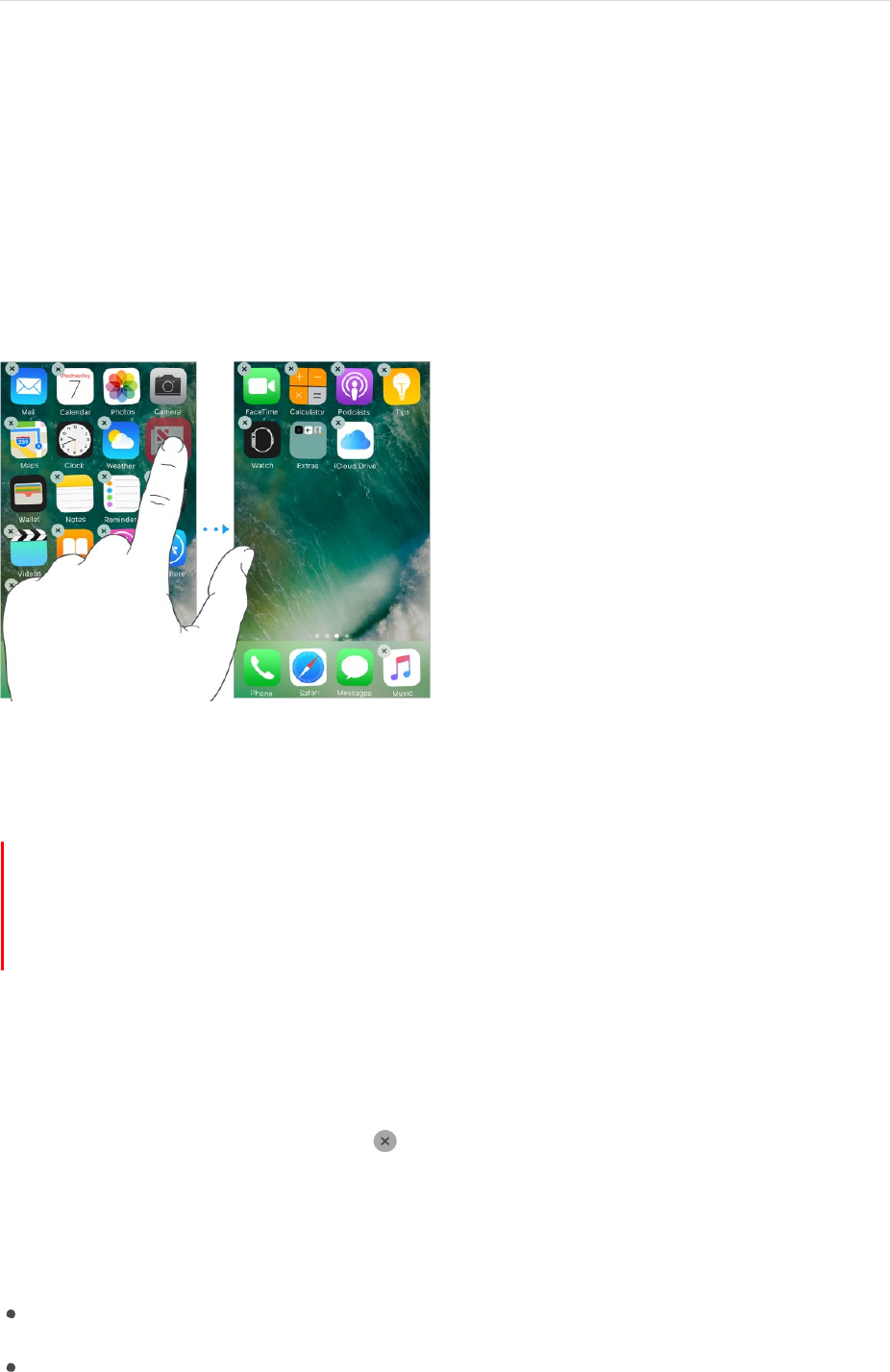
65
!
APPLE CONFIDENTIAL
Personalize your iPhone
Arrange your apps
Arrange apps. Touch and hold any app on the Home screen until you see the app icons
jiggle. Drag an app to move it. Drag an app to the edge of the screen to move it to a
different Home screen, or to the Dock at the bottom of the screen (remove another app
first). Press the Home button to save your arrangement.
Create a new Home screen. While arranging apps, drag an app to the right edge of the
last Home screen. The dots above the Dock show how many Home screens you have,
and which one you’re viewing.
Start over. Go to Settings > General > Reset, then tap Reset Home Screen Layout to
return the Home screen and apps to their original layout. Any folders you’ve created are
removed, the original wallpaper is restored and apps you’ve downloaded are placed
after apps that came with your iPhone.
Remove apps
Remove apps from the Home screen. Touch and hold an app on the Home screen until
you see the app icons jiggle, then tap
in the upper-right corner. When you finish,
press the Home button.
In addition to removing third-party apps, you can remove some built-in Apple apps that
come with your iPhone:
Calculator
Calendar
DRAFT

66
!
Compass
APPLE CONFIDENTIAL
Contacts (Contact information remains available through the Phone app.)
FaceTime
Find My Friends
Home
iBooks
iCloud Drive
iTunes Store
Mail
Maps
Music (Also removes the Music app from CarPlay.)
News
Notes
Podcasts
Reminders
Stocks
Tips
Videos
Voice Memos
Watch
Weather
Note: When you remove a built-in app from your Home screen, you also remove any
related user data and configuration files. Removing built-in apps from your Home
screen can affect other system functionalities. For more information about removing
built-in apps, go to the Remove built-in apps from the Home screen on your iOS device
website.
Restore an app you removed. Go to the App Store, search for the app, then tap
DRAFT

67
!
APPLE CONFIDENTIAL
Organize with folders
Create a folder. While arranging apps, drag one app onto another. Tap the name of the
folder to rename it. Drag apps into or out of the folder. Press the Home button when you
finish.
You can have multiple pages of apps in a folder.
Delete a folder. Drag out all the apps—the folder is deleted automatically.
Change the wallpaper
Wallpaper settings let you set an image or photo as wallpaper for the Lock screen or
Home screen. You can choose from dynamic and still images.
Change the wallpaper. Go to Settings > Wallpaper > Choose a New Wallpaper.
Tip: If you choose an image of your own as wallpaper, you can pinch open to zoom
in on your selected image, then drag your finger to move the image. Pinch closed to
zoom back out.
DRAFT

68
!
APPLE CONFIDENTIAL
When choosing an image for new wallpaper, you may be able to tap Perspective to
make your wallpaper move when you change the angle you view the screen. To turn on
the Perspective option for wallpaper you already set, go to the Wallpaper setting, then
tap the image of the Lock screen or Home screen.
Note: The Perspective option doesn’t appear if Reduce Motion (in Accessibility
settings) is turned on. See Reduce screen motion.
Set a Live Photo as wallpaper for the Lock screen. On devices with 3D Touch, go to
Settings > Wallpaper > Choose a New Wallpaper. Tap Live, then choose a Live Photo. To
set one of your own Live Photos as the wallpaper for the Lock screen, choose one from
one of your folders (below Photos).
3D Touch. When you’re on the Lock screen, press to play the Live Photo. See
3D Touch.
Adjust the screen brightness and color balance
Dim the screen or use Auto-Brightness to extend battery life. Use Night Shift to shift the
colors in your display to the warmer end of the spectrum at night and make viewing the
screen easier on your eyes.
DRAFT
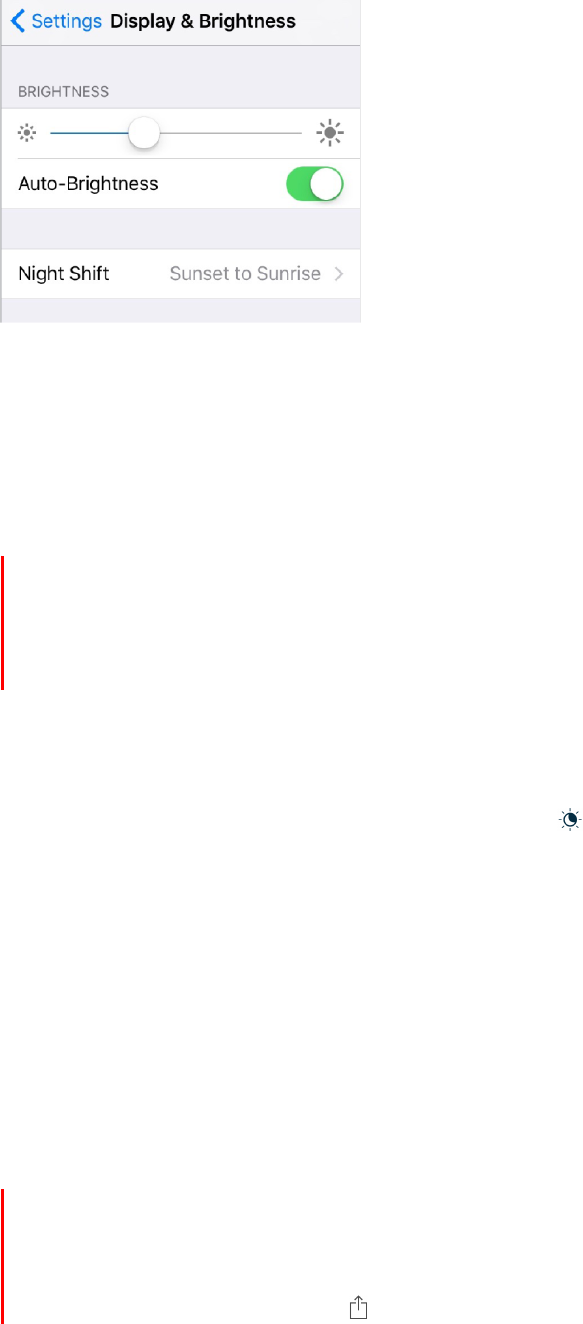
69
!
APPLE CONFIDENTIAL
Adjust the screen brightness. Go to Settings > Display & Brightness, then drag the
slider. If Auto-Brightness is on, iPhone adjusts the screen brightness for current light
conditions using the built-in ambient light sensor. You can also adjust the brightness in
Control Center.
Use Night Shift. Go to Settings > Display & Brightness > Night Shift.
Turn on Night Shift manually, helpful when you’re in a darkened room during the day, for
example, or schedule it to turn on automatically. If you schedule Night Shift to turn on
from sunset to sunrise, iPhone uses the data from your clock and your geolocation to
determine when it’s nighttime for you.
To adjust the color balance for Night Shift, go to Settings > Display & Brightness > Night
Shift, then drag the slider toward the warmer or cooler end of the spectrum.
You can also turn on Night Shift in Control Center. Tap .
Display Zoom
On supported devices, you can magnify the screen display. Go to Settings > Display &
Brightness. Tap View (below Display Zoom), choose Zoomed, then tap Set. For additional
zoom features, see Zoom.
App extensions
Some apps let you extend the functionality of your iPhone. An app extension may
appear as a sharing option, an action option, a widget in Today, a file provider, or a
custom keyboard. For example, if you download Pinterest, Pinterest becomes another
option for sharing when you click .
DRAFT
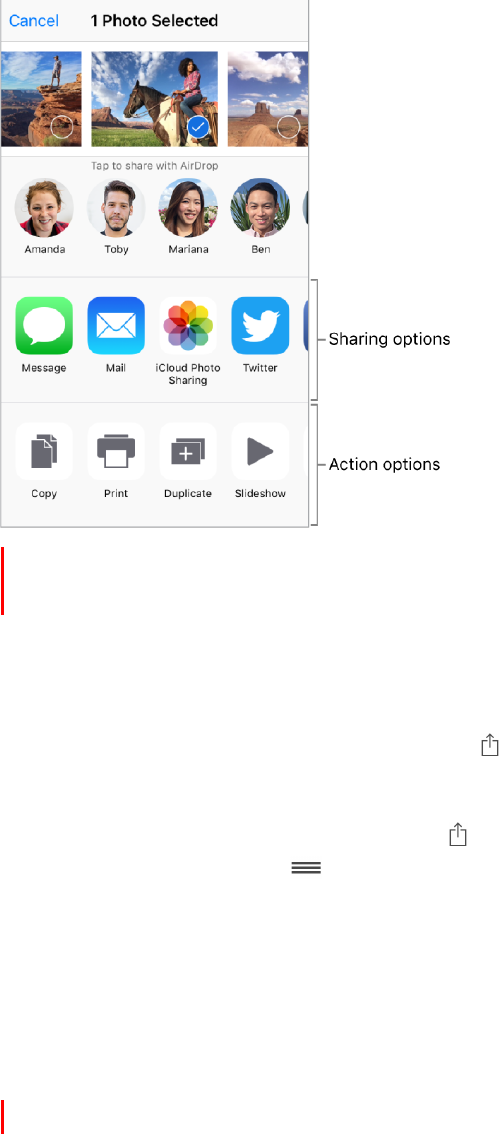
70
!
APPLE CONFIDENTIAL
App extensions can also help you edit a photo or video in your Photos app. For example,
you can download a photo-related app that lets you apply filters to photos.
Install app extensions. Download the app from the App Store, then open the app and
follow the onscreen instructions.
Turn sharing or action options on or off. Tap , then tap More (drag options to the left
if necessary). Turn off third-party sharing or action options (they are on by default).
Organize sharing and action options. Tap , then tap More (drag options to the left if
necessary). Touch and drag
to rearrange your options.
For more information about Today widgets, see Today View. For more information about
Sharing options, see Share from apps.
Your iPhone name
The name of your iPhone is used by iTunes and iCloud.
Change the name of your iPhone. Go to Settings > General > About > Name.
Set Restrictions
You can set restrictions for some apps, and for purchased content. For example, parents
can restrict explicit music from appearing in playlists, or disallow changes to certain
settings. Use restrictions to prevent the use of certain apps, the installation of new apps,
or changes to accounts or the volume limit.
DRAFT
71
!
APPLE CONFIDENTIAL
Turn on restrictions. Go to Settings > General > Restrictions, then tap Enable
Restrictions. You’ll be asked to define a restrictions passcode that’s necessary to change
the settings you make. This can be different from the passcode for unlocking iPhone.
Important: If you forget your restrictions passcode, you must restore the iPhone
software. See Restore iPhone.
DRAFT

72
!
APPLE CONFIDENTIAL
International keyboards
Use international keyboards
With international keyboards you can type text in many different languages, including
Asian languages and languages written from right to left. For a list of supported
keyboards, go to the Apple iPhone website, choose your iPhone, click Tech Specs, then
scroll to Languages.
Manage keyboards. Go to Settings > General > Keyboard > Keyboards.
Add a keyboard: Tap Add New Keyboard, then choose a keyboard from the list.
Repeat to add more keyboards.
Remove a keyboard: Tap Edit, tap
next to the keyboard you want to remove, tap
Delete, then tap Done.
Edit your keyboard list: Tap Edit, drag
next to a keyboard to a new place in the list,
then tap Done.
If you’ve added keyboards in other languages, you can type in two languages at the
same time without having to switch between keyboards.
Switch keyboards. Touch and hold , then slide your finger to the name of the
keyboard.
You can also tap to switch from one keyboard to the other. Continue tapping to
access other enabled keyboards.
Enter accented letters or other characters. Touch and hold the related letter, number,
or symbol, then slide to choose a variant. For example:
On a Thai keyboard: Choose native numbers by touching and holding the related
Arabic number.
On a Chinese, Japanese, or Arabic keyboard: Suggested characters or candidates
appear at the top of the keyboard. Tap a candidate to enter it, or swipe left to see
more candidates.
Use the extended suggested candidate list. Tap the up arrow on the right to view the
full candidate list. To return to the short list, tap the down arrow
When using certain Chinese or Japanese keyboards, you can create a shortcut (text
replacement) for word and input pairs. The shortcut is added to your personal dictionary.
When you type a shortcut while using a supported keyboard, the paired word or input is
substituted for the shortcut.
DRAFT

73
!
APPLE CONFIDENTIAL
Create shortcuts. Go to Settings > General > Keyboard > Text Replacement. Shortcuts
are available for:
Simplified Chinese: Pinyin
Traditional Chinese: Pinyin and Zhuyin
Japanese: Romaji and Kana
Reset your personal dictionary. Go to Settings > General > Reset > Reset Keyboard
Dictionary. All custom words and shortcuts are deleted, and the keyboard dictionary
returns to its default state.
Special input methods
You can use keyboards to enter some languages in different ways. A few examples are
Chinese Cangjie and Wubihua, Japanese Kana, and Facemarks. You can also use your
finger or a stylus to write Chinese characters on the screen.
Build Chinese characters from the component Cangjie keys. As you type, suggested
characters appear. Tap a character to choose it, or continue typing up to five
components to see more options.
Build Chinese Wubihua (stroke) characters. Use the keypad to build Chinese
characters using up to five strokes, in the correct writing sequence: horizontal, vertical,
left falling, right falling, and hook. For example, the Chinese character (circle) should
begin with the vertical stroke
I.
As you type, suggested Chinese characters appear (the most commonly used
characters appear first). Tap a character to choose it.
If you’re not sure of the correct stroke, enter an asterisk (*). To see more character
options, type another stroke, or scroll through the character list.
Tap the match key (c) to show only characters that match exactly what you typed.
Write Chinese characters. Write Chinese characters directly on the screen with your
finger when Simplified or Traditional Chinese handwriting input is turned on.
3D Touch. Press a little deeper as you write to increase the line width of your
character strokes. See 3D Touch.
As you write character strokes, iPhone recognizes them and shows matching characters
in a list, with the closest match at the top. When you choose a character, its likely follow-
on characters appear in the list as additional choices.
COMMENT: FPO screenshot below
DRAFT
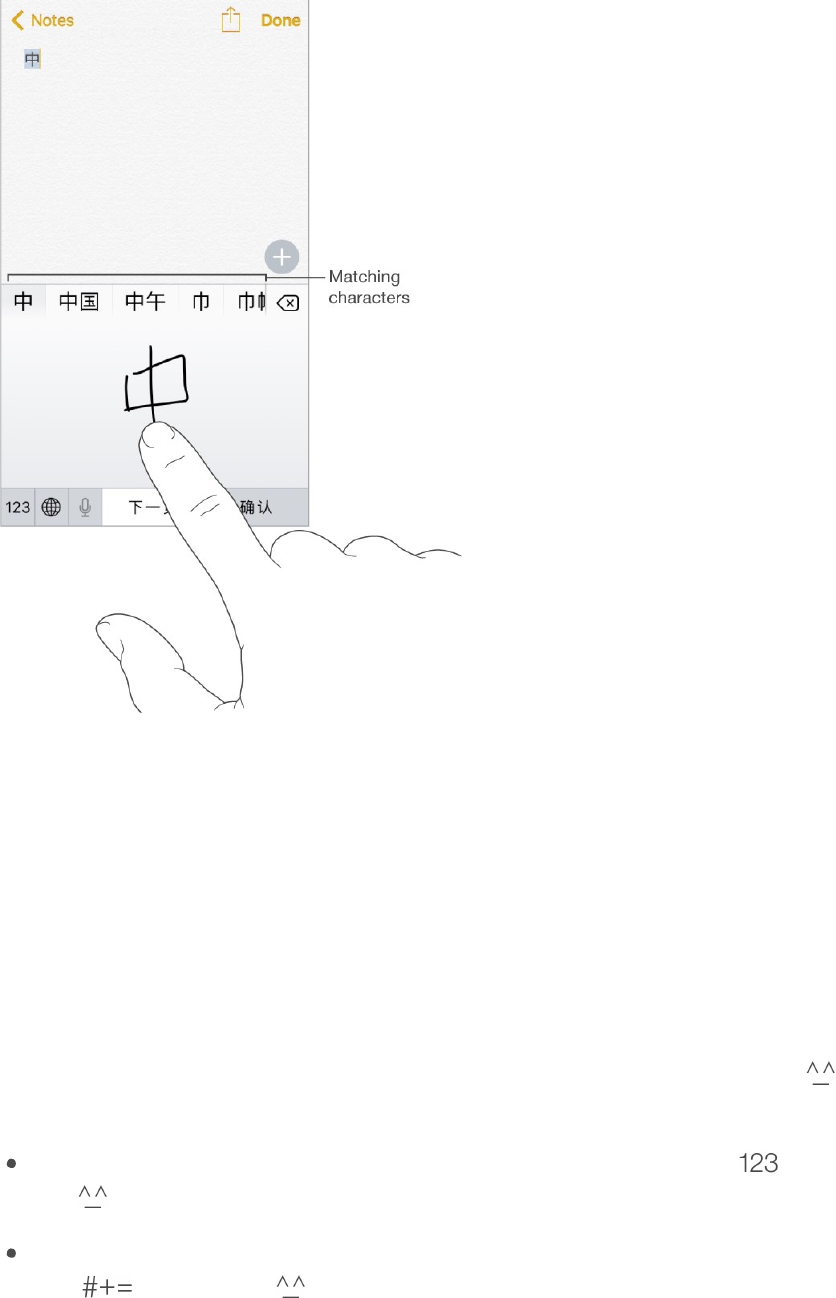
74
!
APPLE CONFIDENTIAL
You can type some complex characters, such as
tl
(part of the name for the Hong Kong
International Airport), by writing two or more component characters in sequence. Tap the
character to replace the characters you typed. Roman characters are also recognized.
Type Japanese kana. Use the Kana keypad to select syllables. For more syllable
options, drag the list to the left or tap the arrow key.
Type Japanese romaji. Use the Romaji keyboard to type syllables. Alternative choices
appear along the top of the keyboard; tap one to type it. For more syllable options, tap
the arrow key and select another syllable or word from the window.
Type facemarks or emoticons. Use the Japanese Kana keyboard and tap the
key. Or
you can:
Use the Japanese Romaji keyboard (QWERTY-Japanese layout): Tap , then tap
the
key.
Use the Chinese (Simplified or Traditional) Pinyin or (Traditional) Zhuyin keyboard:
Tap
, then tap the
key.
DRAFT
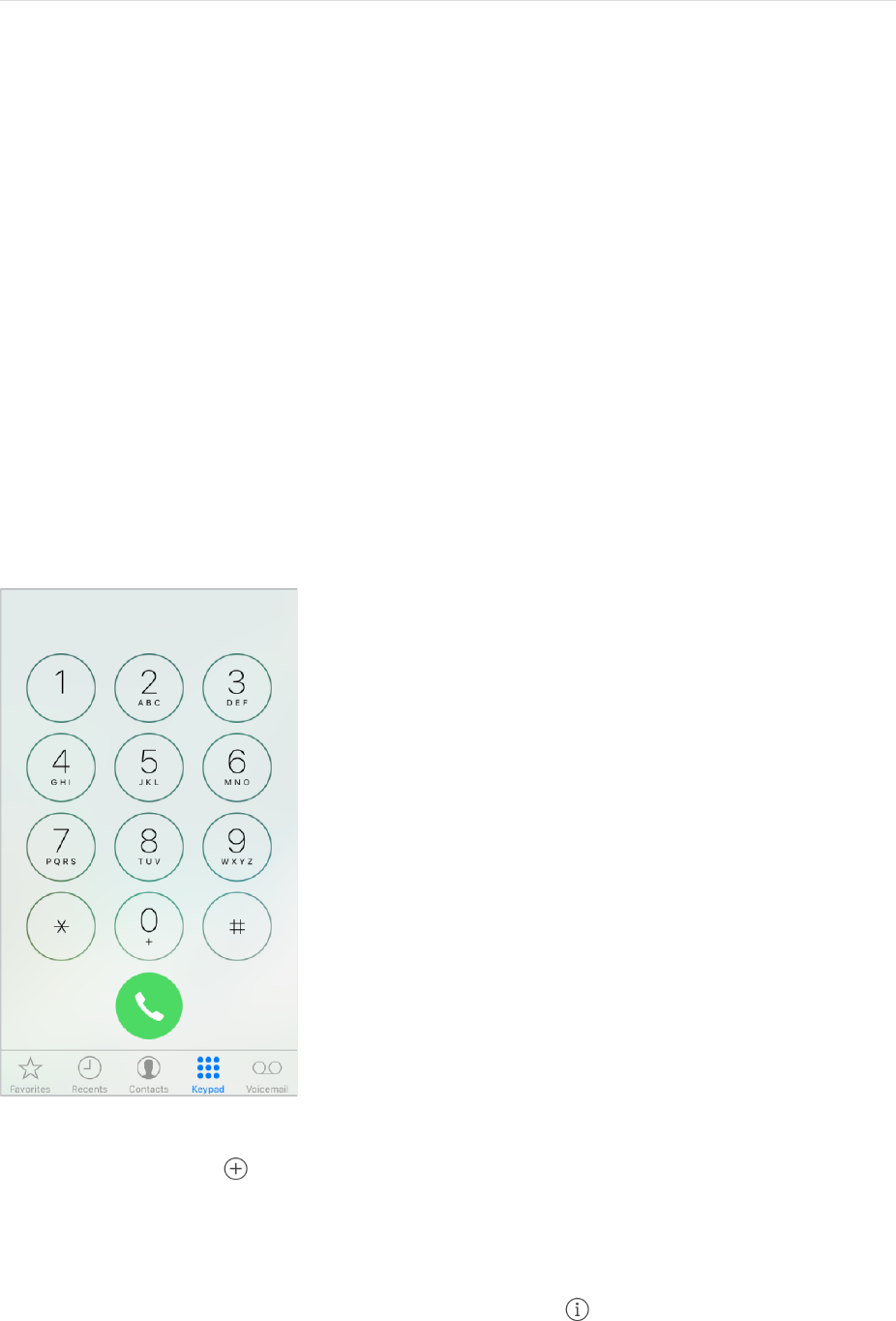
75
!
APPLE CONFIDENTIAL
Apps
Phone
Phone calls
Make a call
Making a call on iPhone is as simple as choosing a number in your contacts, or tapping
one of your favorites or recent calls.
WARNING: For important information about avoiding distractions that could lead to
dangerous situations, see Important safety information.
Add favorites. With Favorites, you can make a call with a single tap. To add someone to
your Favorites list, tap . You can also add names to Favorites from Contacts. In
Contacts, tap Add to Favorites at the bottom of a card, then tap the number to add.
Delete a name or rearrange your Favorites list. Tap Edit.
Return a recent call. Tap Recents, then tap the call. Tap
to get more info about the
call, or the caller. A red badge indicates the number of missed calls.
DRAFT

76
!
APPLE CONFIDENTIAL
You can also reach recent and favorite people you’ve been in contact with from the
multitasking screen—just double-click the Home button.
Dial manually. Tap Keypad, enter the number, then tap Call.
Paste a number to the keypad: Tap the screen above the keyboard, then tap Paste.
Enter a soft (2-second) pause: Touch the “*” key until a comma appears.
Enter a hard pause (to pause dialing until you tap the Dial button): Touch the “#” key
until a semicolon appears.
Redial the last number: Tap Keypad, tap Call to display the number, then tap Call
again.
Use Siri or Voice Control. Press and hold the Home button, say “call” or “dial,” then say
the name or number. You can add “at home,” “work,” or “mobile.” See Make requests and
Voice Control. For example:
“Call Emily’s mobile”
“Call the fire department”
“Redial that last number”
When voice dialing a number, speak each digit separately—for example, “four one five,
five five five….” For the 800 area code in the U.S., you can say “eight hundred.”
Use Wi-Fi Calling on your iPhone. (Available with some carriers) Go to Settings >
Phone > Wi-Fi Calling, then turn Wi-Fi Calling on This iPhone on.
Tip: Wi-Fi Calling can be helpful when your iPhone has a low cell signal, because it
uses your Wi-Fi network to make the call.
When someone calls
Tap Accept to answer an incoming call. Or if iPhone is locked, press the Home button.
You can also press the center button on your EarPods.
DRAFT

77
!
APPLE CONFIDENTIAL
Silence a call. Press the Sleep/Wake button or either volume button. You can still answer
the call after silencing it, until it goes to voicemail.
Adjust the volume. Press the volume buttons on the side of your phone to adjust the
volume during a call.
Decline a call and send it directly to voicemail. Do one of the following:
Press the Sleep/Wake button twice quickly.
Press and hold the center button on your headset for about two seconds. Two low
beeps confirm that the call was declined.
Tap Decline (if iPhone is awake when the call comes in).
Note: In some areas, declined calls are disconnected without being sent to voicemail.
Respond with a text message instead of answering. Tap Message, then choose a
reply or tap Custom. To create your own default replies, go to Settings > Phone >
Respond with Text, then tap any of the default messages and replace it with your own
text.
Remind yourself to return the call. Tap Remind Me, then indicate when you want to be
reminded.
COMMENT: New screenshot coming, FPO
Make and receive calls on your iPad, iPod touch, or Mac
Continuity lets you make calls on your other devices by relaying calls through your
iPhone, which must be turned on and connected to a cellular network. To make calls
this way, you need iOS 8 or later, and OS X v10.10 or later. You must be signed in to
iCloud and FaceTime on all devices using the same Apple ID as on iPhone, and all
devices must be connected to the same Wi-Fi network.
Wi-Fi Calling lets you make and receive phone calls on your iPad or iPod touch (iOS 9 or
later), Apple Watch (watchOS 2 or later), or Mac (OS X v10.11 or later), as long as you’re
signed in to iCloud and FaceTime with the same Apple ID on the device you’re using for
calls. Your iPhone doesn't need to be on the same network as your other devices or
even turned on.
Note: Wi-Fi Calling on other devices is available with some carriers, and cellular charges
may apply.
DRAFT
78
!
APPLE CONFIDENTIAL
You must first set up your iPhone (iPhone 5c, iPhone 5s, and later), then your other
devices. If you log out of iCloud or FaceTime on iPhone, Wi-Fi Calling is disabled.
Note: When making calls on iPhone SE, iPhone 6, iPhone 6 Plus, and later, if the Wi-Fi
connection is lost, calls switch automatically to your carrier’s cellular network using
VoLTE (Voice over LTE), if available and turned on. See Cellular data settings. (VoLTE
calls also switch to Wi-Fi when a Wi-Fi connection becomes available.) On earlier iPhone
models, and on iPad, iPod touch, or a Mac, a call is dropped if you lose the Wi-Fi
connection. Contact your carrier for feature availability.
Turn on Wi-Fi Calling on your iPhone. Go to Settings > Phone > Wi-Fi Calling, then turn
Wi-Fi Calling on This iPhone on.
If you see Add Wi-Fi Calling For Other Devices, tap it to allow calls from other devices
that aren’t on the same Wi-Fi network as your iPhone. Otherwise, you can still use your
other devices to make phone calls, but your iPhone must be turned on and on the same
network as your other devices.
Turn on Wi-Fi Calling on another iOS device. On the device, go to Settings > FaceTime,
then turn on FaceTime. If you’re asked, turn Wi-Fi calling on.
Turn on Wi-Fi Calling on your Mac. On your Mac, open FaceTime, then choose
FaceTime > Preferences > Settings. Select “Calls from iPhone.” If an Upgrade to Wi-Fi
Calling button appears, click it, then follow the instructions.
Receive a call on your iPad, iPod touch, or Mac. Swipe or click the notification to
answer, ignore, or respond with a quick message.
Make a call from your iPad, iPod touch, or Mac. Tap or click a phone number in
Contacts, Calendar, FaceTime, Messages, Spotlight, or Safari.
Note: Emergency calls on your iPhone are routed through cellular service when available.
In the event that cellular service is not available, and you have enabled Wi-Fi Calling,
emergency calls may be made over Wi-Fi, and your device’s location information may be
used for emergency calls to aid response efforts, regardless of whether you enable
Location Services. Some carriers may use the address you registered with the carrier
when signing up for Wi-Fi Calling as your location.
For more information about Wi-Fi calls, see the Apple support article Make a call with Wi-
Fi Calling.
DRAFT
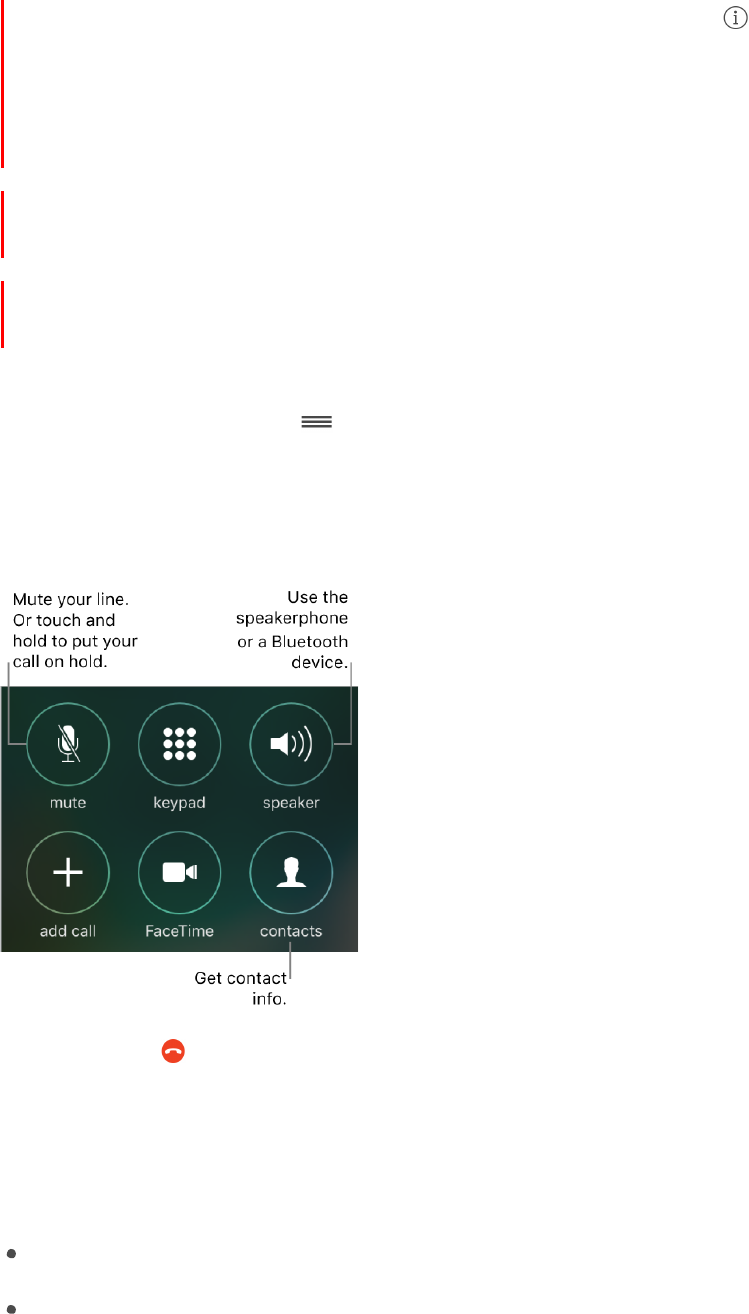
79
!
APPLE CONFIDENTIAL
Avoid unwanted calls
Block unwanted callers. On a contact card, tap Block this Caller (tap
in Favorites or
Recents to see a caller’s contact card) ). You can also block callers in Settings >
Phone > Blocking & Identification. You don’t receive voice calls, FaceTime calls, or text
messages from blocked callers. For more information about blocking calls, see the
Apple support article Block calls and block or filter messages.
Identify spam calls. Download a spam-blocking app from the App Store, and iPhone
alerts you to potential spam calls.
To view your spam-blocking apps on iPhone, go to Settings > Phone > Call Blocking and
Identification.
If you have multiple spam-blocking apps, you can change which one checks an unknown
number first. Touch and hold , then drag to position.
While on a call
When you’re on a call, the screen shows several call options.
End a call. Tap
or press the Sleep/Wake button.
Use another app while on a call. Press the Home button, then open the app. To return
to the call, tap the green bar at the top of the screen.
Respond to a second call. You can:
Ignore the call and send it to voicemail: Tap Ignore.
Put the first call on hold and answer the new one: Tap Hold + Accept.
DRAFT

80
!
APPLE CONFIDENTIAL
End the first call and answer the new one: When using a GSM network, tap End +
Accept. With a CDMA network, tap End and when the second call rings back, tap
Accept, or drag the slider if iPhone is locked.
With a call on hold, tap Swap to switch between calls, or tap Merge Calls to talk with both
parties at once. See Conference calls.
Note: With CDMA, you can’t switch between calls if the second call was outgoing, but
you can merge the calls. You can’t merge calls if the second call was incoming. If you end
the second call or the merged call, both calls are terminated.
Conference calls
With GSM, you can set up a conference call with up to five people (depending on your
carrier).
Note: Conference calls may not be available if your call is using VoLTE (Voice over LTE).
Create a conference call. While on a call, tap Add Call, make another call, then tap
Merge Calls. Repeat to add more people to the conference.
Drop one person: Tap
next to a person, then tap End.
Talk privately with one person: Tap , then tap Private next to the person. Tap Merge
Calls to resume the conference.
Add an incoming caller: Tap Hold Call + Answer, then tap Merge Calls.
Emergency calls
Make an emergency call when iPhone is locked. On the Enter Passcode screen, tap
Emergency Call (to dial 911 in the U.S., for example).
Important: You can use iPhone to make an emergency call in many locations, provided
that cellular service is available, but you should not rely on it for emergencies. Some
cellular networks may not accept an emergency call from iPhone if iPhone is not
activated, if iPhone is not compatible with or configured to operate on a particular
cellular network, or (when applicable) if iPhone does not have a SIM card or if the SIM
card is PIN-locked.
In the U.S., location information (if available) is provided to emergency service providers
when you dial 911 or tap Emergency Call. If you tap Emergency Call or dial an
emergency number outside of the U.S., your location information may also be provided
to emergency providers if your carrier supports it. Please review your carrier’s
emergency calling information to understand the limits of emergency calling over Wi-Fi.
DRAFT
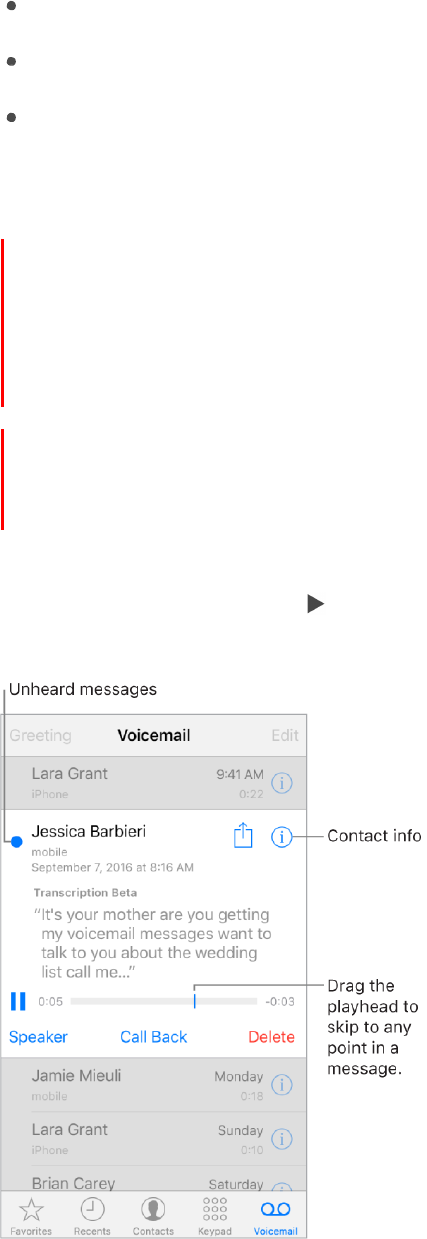
81
!
APPLE CONFIDENTIAL
With CDMA, when an emergency call ends, iPhone enters emergency call mode for a few
minutes to allow a call back from emergency services. During this time, data
transmission and text messages are blocked.
Exit emergency call mode (CDMA). Do one of the following:
Tap the Back button.
Press the Sleep/Wake button or the Home button.
Use the keypad to dial a non-emergency number.
Visual voicemail
Visual voicemail lets you see a list of your messages. You can choose which ones to
listen to, view transcriptions of messages, or delete them, all without having to wade
through all of them. A badge on the Voicemail icon tells you how many unheard
messages you have. The first time you tap Voicemail, you’re asked to create a voicemail
password and record your voicemail greeting.
Note: Voicemail transcription Beta is available in English and depends on the quality of
the recording. You won’t see transcriptions for voicemails you received before you
upgraded iPhone to iOS 10.
Listen to a voicemail message. Tap Voicemail, then select a message. To listen again,
select the message, then tap . If visual voicemail isn’t available with your service, tap
Voicemail and follow the voice instructions.
DRAFT

82
!
APPLE CONFIDENTIAL
Messages are saved until you delete them or your carrier erases them.
Ask Siri. Say something like:
“Do I have any new voicemail?”
“Play the voicemail from Emily”
Delete a message. Swipe or tap the message, then tap Delete.
Note: In some areas, deleted messages may be permanently erased by your carrier. Your
voice messages may also be deleted if you change your SIM card.
Manage deleted messages. Tap Deleted Messages (at the end of the messages list),
then:
Listen to a deleted message: Tap the message.
Undelete a message: Tap the message and tap Undelete.
Delete messages permanently: Tap Clear All.
Share a message. Tap a message, then tap .
Update your greeting. Tap Voicemail, tap Greeting, tap Custom, then tap Record. Or, to
use your carrier’s generic greeting, tap Default.
Set an alert sound for new voicemail. Go to Settings > Sounds.
Change the password. Go to Settings > Phone > Change Voicemail Password. If you
forgot your voicemail password, contact your wireless carrier.
Contacts
When viewing a contact’s card, a quick tap lets you make a phone call, create an email
message, find the contact’s location, and more. See Use Contacts from within the Phone
app.
See the phone number for your iPhone. Tap Contacts, then scroll to the to the top your
contact list.
3D Touch. To add a contact from the Home screen, press Phone, then choose the
Create New Contact quick action. See 3D Touch.
Call forwarding, call waiting, and caller ID
Set up call forwarding, call waiting, or caller ID. (GSM) Go to Settings > Phone.
DRAFT

83
!
APPLE CONFIDENTIAL
Call Forwarding: The Call Forwarding icon
appears in the status bar when call
forwarding is on. You must be in range of the cellular network when you set iPhone to
forward calls, or calls won’t be forwarded.
Call Waiting: If you’re on a call and call waiting is turned off, incoming calls go directly
to voicemail.
Caller ID: For FaceTime calls, your phone number is displayed even if caller ID is
turned off.
For CDMA accounts, contact your carrier for information about enabling and using these
features.
For more information, see the Apple Support article Call forwarding, call waiting, and
other call features on iPhone.
Ringtones and vibrations
iPhone comes with ringtones that sound for incoming calls, Clock alarms, and the Clock
timer. You can also purchase ringtones from songs in the iTunes Store. See Purchase,
rent, or redeem.
Set the default ringtone. Go to Settings > Sounds > Ringtone. (On 2016 IPHONE/2016
IPHONE PLUS, go to
Settings > Sounds & Haptics > Ringtone.)
Assign different ringtones for the special people in your life. Go to Contacts, choose
a contact, tap edit, then tap Ringtone.
Turn the ringer on or off. Flip the switch on the side of iPhone.
Important: Clock alarms still sound when the Ring/Silent switch is set to silent.
Turn vibrate on or off. Go to Settings > Sounds. (On 2016 IPHONE/2016 IPHONE
PLUS, go to Settings > Sounds
& Haptics.) See Sounds and silence.
Set the sound for new voicemail. Go to Settings > Sounds > New Voicemail. (On
2016
IPHONE/2016 IPHONE PLUS, go to Settings > Sounds & Haptics > New Voicemail.)
International calls
For information about making international calls from your home area (including rates
and other charges that may apply), contact your carrier.
When traveling abroad, you may be able to use iPhone to make calls, send and receive
text messages, get visual voicemail, and use apps that access the Internet, depending on
available networks.
DRAFT

84
!
APPLE CONFIDENTIAL
Enable international roaming. To turn on Data Roaming and Voice Roaming (CDMA), go
to Settings > Cellular. Contact your carrier for information about availability and fees.
Important: Voice, text message, and data roaming charges may apply. To avoid charges
while roaming, turn off Data Roaming and Voice Roaming (CDMA).
You may be able to roam on GSM networks, if you have a CDMA account, and your
iPhone has a SIM card installed. While roaming on a GSM network, iPhone has access to
GSM network features. Charges may apply. Contact your carrier for more information.
Set network options. Go to Settings > Cellular to:
Turn data roaming on or off
Turn cellular data on or off
Turn voice roaming on or off (CDMA)
Use GSM networks abroad (CDMA)
See Cellular data settings.
Turn off cellular services. Go to Settings, turn on Airplane Mode, then tap Wi-Fi and
turn it on. Incoming phone calls are sent to voicemail. To resume cellular service, turn
Airplane Mode off.
Make calls to your contacts and favorites while traveling abroad. (GSM) Go to
Settings > Phone, then turn on Dial Assist. Dial Assist automatically adds the prefix or
country code for calls to the U.S.
Select a carrier network. Go to Settings > Carrier. This setting appears on GSM
networks when you’re outside your carrier’s network, and other local carrier data
networks are available to use for your phone calls, visual voicemail, and cellular network
Internet connections. You can make calls only on carriers that have a roaming agreement
with your carrier. Additional fees may apply. Roaming charges may be billed to you by the
other carrier, through your carrier.
Once you select a network, iPhone uses only that network. If the network you chose is
unavailable, “No service” appears on iPhone. To look for a different carrier network, go
back to Settings > Carrier.
Get voicemail when visual voicemail isn’t available. Dial your own number (with
CDMA, add # after your number), or touch and hold “1” on the numeric keypad.
DRAFT

85
!
APPLE CONFIDENTIAL
Safari
Safari at a glance
Use Safari on iPhone to browse the web, use Reading List to collect webpages to read
later, and add page icons to the Home screen for quick access. If you're signed in to
iCloud with the same Apple ID on all your devices, you can see pages you have open on
other devices, and keep your bookmarks, history, and reading list up to date on your
other devices.
Search the web
Search the web. Enter a URL or search term in the search field at the top of the page,
then tap a search suggestion, or tap Go on the keyboard to search for exactly what you
typed. If you don’t want to see suggested search terms, go to Settings > Safari, then
(under Search) turn off Search Engine Suggestions.
DRAFT
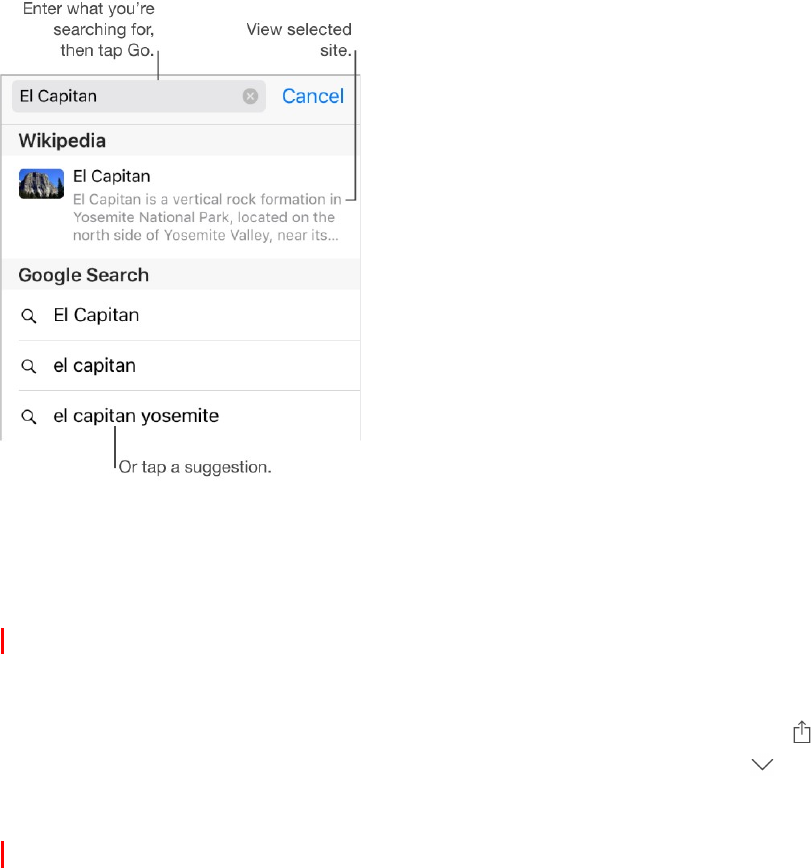
86
!
APPLE CONFIDENTIAL
Quickly search a site you’ve visited before. Enter the name of the site, followed by
your search term. For example, enter “wiki einstein” to search Wikipedia for “einstein.”
Go to Settings > Safari > Quick Website Search to turn this feature on or off.
See your favorites when you enter an address, search, or create a new tab. Select
the folder containing your favorites at Settings > Safari > Favorites.
Search the page. To find a specific word or phrase on the current page, tap , then tap
Find on Page. Enter the word or phrase in the search field to search. Tap
to find other
instances.
Choose your search engine. Go to Settings > Safari > Search Engine.
Browse the web
3D Touch. To open items from the Home screen, press the Safari icon, then choose a
quick action. See 3D Touch
Look before you leap. To see the URL of a link before you go there, touch and hold the
link.
DRAFT
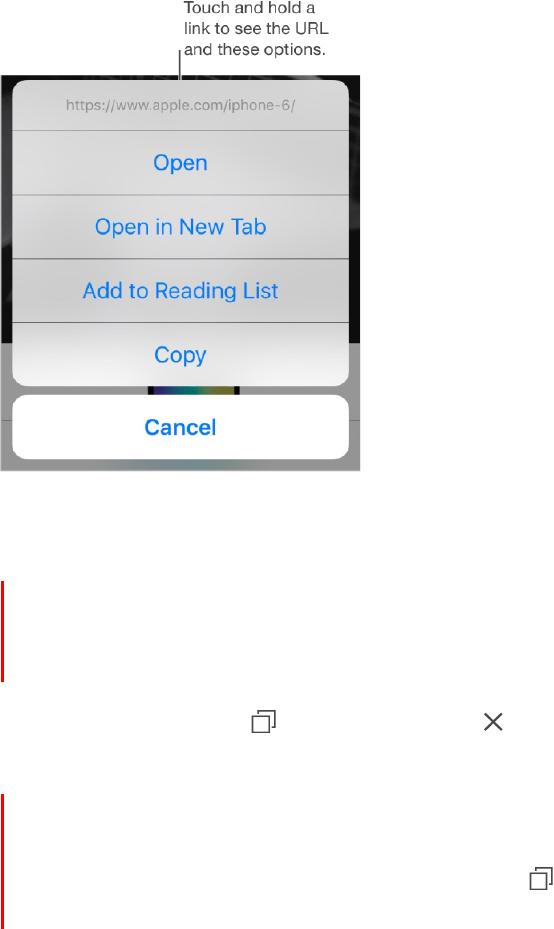
87
!
APPLE CONFIDENTIAL
3D Touch. To preview items, press a link to get a peek. Press a little deeper to open
it. See 3D Touch
Open a link in a new tab. Touch and hold the link, then tap Open in New Tab. If you
prefer to stay on the current tab while opening a link in another tab, go to Settings >
Safari > Open Links, then tap In Background.
Browse open tabs. Tap . To close a tab, tap
in the upper-left corner, or swipe the
tab to the left.
View tabs that are open on your other devices. If you're signed in to iCloud with the
same Apple ID on all your devices, and you turn on Safari in Settings > iCloud, you can
view tabs that are open on your other devices. Tap , then scroll to the list at the
bottom. To close a tab, swipe left, then tap Close.
DRAFT
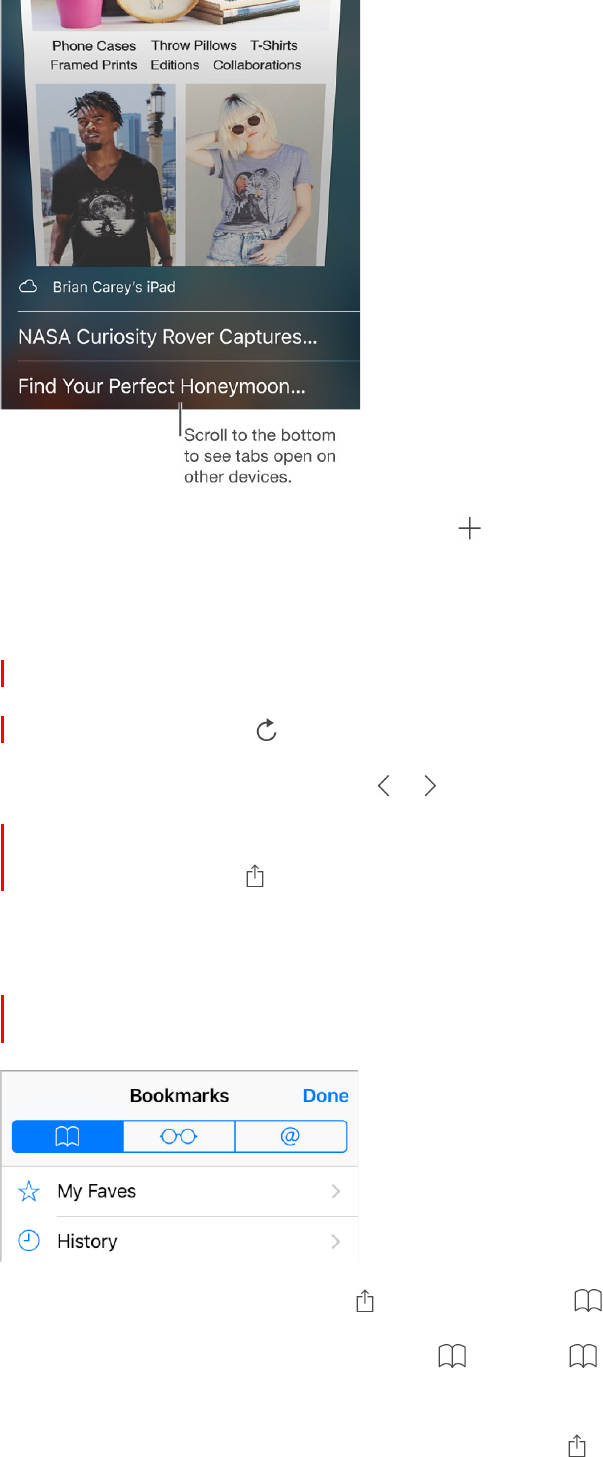
88
!
APPLE CONFIDENTIAL
View recently closed tabs. Touch and hold .
Get back to the top. Tap the top edge of the screen to quickly return to the top of a long
page.
See more of the page. Turn iPhone to landscape orientation.
Refresh the page. Tap
next to the address in the search field to update the page.
See a tab’s history. Touch and hold
or
.
View the desktop version of a site. To see the full desktop version of a site instead of
the mobile version, tap , then tap Request Desktop Site.
Block pop-ups. Go to Settings > Safari, then turn Block Pop-Ups on or off.
Add bookmarks and favorites
Bookmark the current page. Tap
(or touch and hold ), then tap Add Bookmark.
View and organize your bookmarks. Tap , then tap . To create a folder for
bookmarks, tap Edit
Add a webpage to your favorites. Open the page, tap , then tap Add to Favorites.
DRAFT

89
!
APPLE CONFIDENTIAL
Quickly see your favorite and frequently visited sites. Tap the search field to see
your favorites. Scroll down to see frequently visited sites. (To avoid seeing a list of these
sites, go to Settings > Safari, then turn off Frequently Visited Sites.)
Edit your favorites. Tap , tap Favorites, then tap Edit to delete, rename, or change the
order of favorites.
Choose which favorites appear when you tap the search field. Go to Settings >
Safari > Favorites.
See your Mac bookmarks on iPhone. Go to Settings > iCloud, then turn on Safari if
you want items from the bookmarks bar in Safari on your Mac to appear in Favorites on
iPhone.
Add an icon for the current page to your Home screen. To quickly access the page
from your Home screen, tap , then tap Add to Home Screen. The icon appears only on
the device where you add it.
Save a reading list for later
Save interesting items in your reading list so you can revisit them later. You can read
pages in your reading list even when you’re not connected to the Internet.
Add the current page to your reading list. Tap , then tap Add to Reading List.
Add a linked page without opening it. Touch and hold the link, then tap Add to Reading
List.
View your reading list. Tap , then tap .
Delete an item from your reading list. In your reading list, swipe the item to the left.
Limit downloads to Wi-Fi connections. To prevent reading list downloads from using
cellular data, go to Settings > Safari, then turn off Use Cellular Data below Reading List.
DRAFT